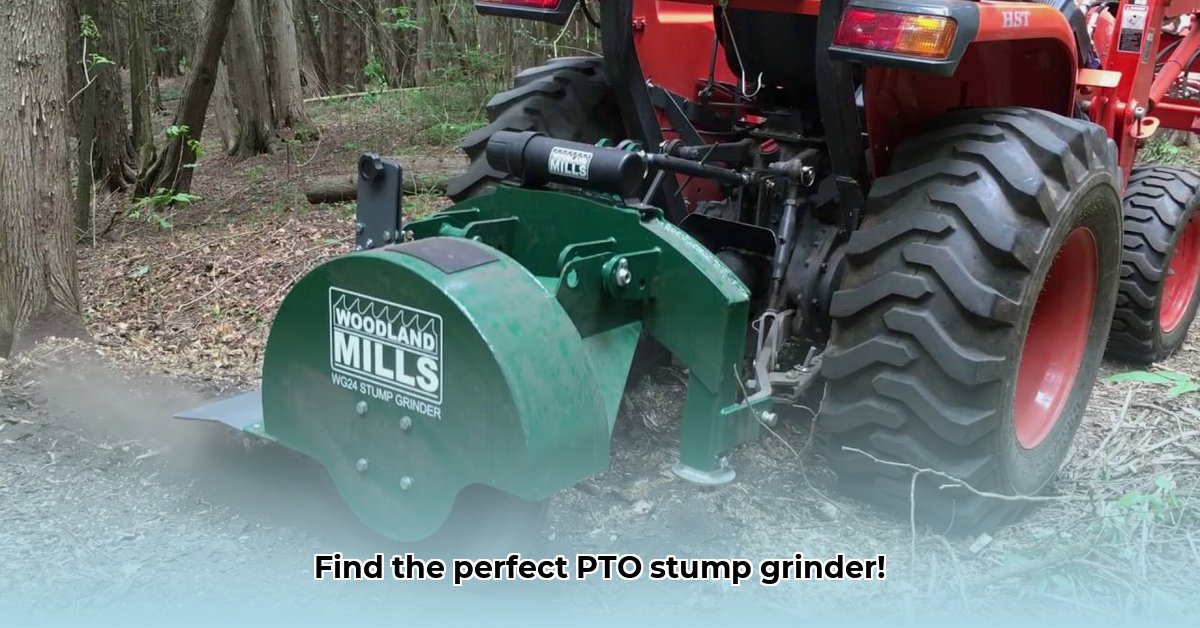
Choosing the right PTO stump grinder is a significant investment for any farmer or landowner. This comprehensive guide compares direct and indirect drive models, helping you select the best option based on your needs and budget. We'll cover key features, advantages, and disadvantages to ensure you make an informed decision. For more information on PTO-driven equipment, check out this helpful resource: PTO equipment guide.
PTO Stump Grinder Drive Systems: Direct vs. Indirect
The core difference between direct and indirect drive PTO stump grinders lies in how power from your tractor's PTO (Power Take-Off) reaches the grinding blades.
Direct Drive: The Workhorse
Imagine a direct line of power. In a direct drive grinder, the PTO shaft directly drives the grinding wheel. This simple design means fewer moving parts, resulting in a typically lower initial cost and generally easier maintenance. Think of it as the reliable workhorse—straightforward, durable, and easily repaired. The Reist Dominator R25PD exemplifies this type. But is it always the best choice? Let's find out.
Indirect Drive: Refined Control
An indirect drive grinder, such as the MechMaxx SG24, uses a gearbox between the PTO and the grinding wheel. This gearbox acts as a translator, allowing independent control over the grinder's speed, regardless of your tractor's PTO speed. This is especially valuable with hydrostatic transmission tractors, offering smoother operation and potentially reducing stress on your tractor's components. It's the more refined option, delivering greater control but typically at a higher price point.
Feature Comparison: Reist Dominator R25PD vs. MechMaxx SG24
The following table provides a direct comparison of key features:
| Feature | Reist Dominator R25PD | MechMaxx SG24 | Notes |
|---|---|---|---|
| Drive Type | Direct | Indirect | Fundamental difference impacting operation |
| PTO Speed Control | Matches tractor's PTO speed | Independent of tractor's PTO speed | Significantly impacts ease of use and efficiency |
| Number of Carbide Teeth | 18 | 34 | More teeth often correlate with faster grinding |
| Price | Typically lower | Typically higher | Consider total cost of ownership (TCO) |
| Ideal Tractor Type | Standard PTO tractors | Hydrostatic drive tractors often preferred | but compatible with others; performance may vary |
| Complexity | Simpler; easier maintenance and repairs | More complex; potentially pricier repairs | Crucial factor in long-term cost |
| Typical Ground Speed Range (mph) | Varies with tractor and ground conditions | Varies with tractor and ground conditions | Consider your typical workload |
How much faster is a grinder with more teeth? Does this justify the higher initial cost? These are crucial questions to consider.
Pros and Cons: Weighing Your Options
Let's examine the advantages and disadvantages of each grinder type to aid your decision.
Reist Dominator R25PD (Direct Drive):
Pros:
- Lower initial cost: Attractive for budget-conscious users or infrequent use.
- Simple design: Easier maintenance and repairs, lowering long-term costs.
- User-friendly operation: Straightforward design suits users with less mechanical experience.
Cons:
- Limited speed control: PTO speed dictates grinder speed, potentially reducing efficiency with varying stump sizes.
- Increased tractor strain: Prolonged use or tough jobs might overstress the tractor's PTO.
"The simplicity of a direct drive grinder is its strength, but its inflexibility can be its downfall," says Dr. Anya Sharma, Agricultural Engineering Professor at Purdue University.
MechMaxx SG24 (Indirect Drive):
Pros:
- Independent speed control: Optimizes grinding speed for diverse conditions, boosting efficiency.
- Smoother operation: Reduces vibrations and stress on both grinder and tractor, extending lifespan.
- Superior for tough jobs: Better control makes it ideal for large-scale projects or challenging conditions.
Cons:
- Higher initial investment: Increased complexity comes with a higher price.
- More complex repairs: More expensive and potentially require specialized technicians.
- Tractor compatibility: While versatile, it performs optimally with hydrostatic transmission tractors.
“While the initial cost of an indirect drive grinder is higher, the long-term efficiency gains often outweigh the investment,” notes Mark Johnson, Farm Equipment Specialist at Iowa State University.
Making the Right Choice: A Decision Guide
Which grinder best suits your operation?
Assess usage frequency: Infrequent use? A direct drive offers cost-effectiveness. Frequent heavy-duty work? An indirect drive's efficiency and control are vital.
Evaluate stump size and density: Large, dense stumps necessitate the torque of an indirect drive. Direct drive suffices for smaller, less resistant stumps.
Consider tractor horsepower: Direct drive systems often require more powerful tractors. Indirect drive optimizes power utilization, making them suitable for lower horsepower tractors.
Factor in budget: While direct drive has a lower initial cost, consider long-term maintenance expenses. Indirect drive might prove more economical over time with intensive use.
Evaluate maintenance capabilities: Direct drive offers simpler maintenance. Choose accordingly based on your mechanical aptitude.
Remember safety is paramount. Always use appropriate safety equipment and adhere to manufacturer instructions. This guide provides valuable information, but seek professional advice for complex projects or uncertainties.